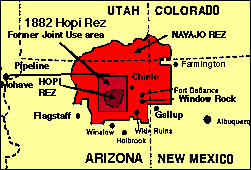 The front page of Friday's Arizona Republic proclaimed the great news: "Hopis, Navajos End 40-year Land Dispute." When I saw it, I couldn't wait to read it. I had written a paper on the subject as part of an Indians of the Southwest course, and was well aware that no resolution had been found after more than 100 years of territorial disputes between these two groups.
The front page of Friday's Arizona Republic proclaimed the great news: "Hopis, Navajos End 40-year Land Dispute." When I saw it, I couldn't wait to read it. I had written a paper on the subject as part of an Indians of the Southwest course, and was well aware that no resolution had been found after more than 100 years of territorial disputes between these two groups.Unfortunately, the news isn't as good as I had hoped. It is true that the two tribes have signed an accord establishing land use guidelines for the disputed area, but legislation which implements the agreement is far from becoming law.
Here's a quick background (for a more detailed look, try this short paper on the topic, also available as a PDF):
The Hopi have lived in villages atop Mesas in northern Arizona for centuries. The Navajo arrived in the region much later, and their subsistence strategies (e.g., herding livestock) involved the use of much more land area than the Hopi. They were also more numerous, and spread quickly to occupy millions of acres of land by the late 1800s, fully encircling the Hopi.
The Hopi repeatedly complained to the U.S. government about Navajo encroachment on the lands they had used for centuries, and a number of acts, lawsuits, and court rulings attempted to resolve the conflict.
Even so, two areas of dispute remained: 1. The Hopi wanted access to sacred (non-residential) ceremonial sites spread across the western portion of the now-expanded Navajo reservation; and 2. A small group of Navajo families still resided within the boundaries of the Hopi reservation, and refused to leave.
In 1966, BIA Commissioner Robert Bennett declared a freeze on all development within the two disputed areas, even prohibiting maintenance of existing buildings or infrastructure. This is what the article refers to as the "Bennett Freeze." In spite of numerous attempts since then to resolve these issues, very little has changed, and the freeze is still in place.
Okay, back to today. Even though the two sides have signed an agreement to put and end to the dispute, there are still dissenters who may fight the outcome. Also, legislation is required to fund the $50 million escrow account and actually lift the freeze. As noted in the article, a bill introduced by Rick Renzi last summer would do all of this, but it has only been approved by subcommittee, and is a long way from becoming law. J.D. Hayworth fought for years to get a bill passed to lift the Bennett Freeze, all without success.
I'd like to point out an inaccuracy in the article (even the title): It is not a 40-year dispute. Yes, it has been 40 years since the Bennett Freeze was put in place, but the dispute began with Hopi petitions to the U.S. government in the early part of the 20th century, and they filed a lawsuit in 1934 against the Navajo Tribe to regain access to the ceremonial sites. So the dispute is at least 72 years old, and actually much older.
One more detail: The Bennett Freeze was lifted in 1992 when the court finally ruled on the 1934 lawsuit. The ruling was seen as a loss by the Hopi, since they did receive access to the land where their village of Moenkopi has existed for hundreds of years, but lost access to the ceremonial sites. The Hopi appealed, and in 1995 the U.S. 9th Circuit granted them access to the ceremonial sites and also reinstated the freeze (So the freeze was actually lifted for threee years, only being reinstated 11 years ago).
No comments:
Post a Comment